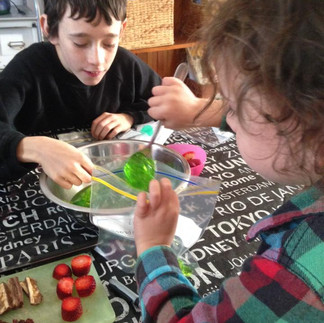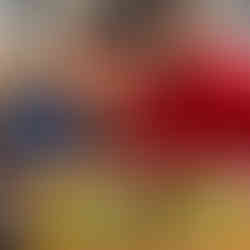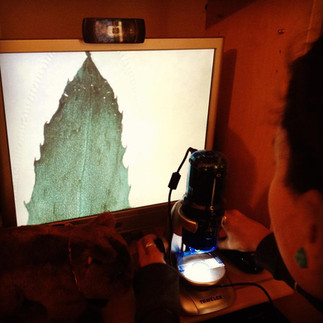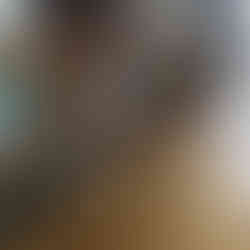EDIBLE SCIENCE (AND HEAPS OF OTHER FUN HANDS-ON SCIENCE IDEAS)
- Lusi Austin
- Sep 8, 2021
- 10 min read
I was asked recently to share some of the edible science activities that we have done together over the years and so thought it was time to create a little throw back post to some of our faves!
I am going to share some of our photos here on the blog now and I'll also link to every single activity that I share over in our paid THL Membership. Part of my aim is to save you time and energy in having all the resources there in one easy to find place for you. Remember that ultimately I'm just one Mum trying to help meet the needs of my kids. That's all any of us can try to do right?
Science doesn't have to scary or boring.
A lil note about science experiments first:
1. Don't let them scare you. Think of them as a way to spark curiosity in your kiddos. Having an enquiring mind is a gift and something that is often dulled too soon in our children. Allowing them the chance to be inquisitive helps to stir curiosity in them about big and little things, from how to the world works to how materials interact with each other and everything in between. Having the chance to be curious is a gift. Give it to them. Take your time too. These experiments were done over a number of years as I gained my confidence with learning and having a go myself!
2. Use what we call our 'science helper' or something similar to help record your scientific discoveries and findings. Why? It helps our kiddos (and ourselves) think scientifically and become familiar with the scientific method from a young age. It becomes less scary to have to write in this way in high school if you are already using it in primary school.
3. I wasn't ever very 'good' at science at school. If I'm completely honest, I wasn't very engaged and therefore, I kind of missed the main points. If you are homeschooling your kiddos, know that you don't have to have excelled at science at school in order to 'do' it at home. Why not? We treat science the SAME WAY we treat other things we don't know in parenting - we FACILIATE THE LEARNING. How? We observe our children, see what they are interested in and what their (and our own) limitations are and then we help to facilitate them moving forward. Sometimes I'll ask questions, sometimes I'll jump online and just google their questions and see if I can find an interesting way in which we can discover the answer together. Either way, just know that you don't have to know everything there is to know about the world in order to facilitate your kiddos learning. Just be prepared to help them do the discovering by helping them access the information they need. You've got this! With all that said, let's jump in!
TECTONIC PLATE SHIFTING
We loved learning about how volcanoes are created when tectonic plates shift using Oreo cookies!

I first tackled this activity with the older kids back in 2017 and it was a hit. They loved cracking the cookies and rearranging them in different ways like this photo below where they placed one cookie slightly over the other in the centre to demonstrate convergent boundary plate shifting. I've since done it with the younger two and they also enjoyed it. Zippi was able to correctly label each example as seen above.

DNA DOUBLE HELIX CREATIONS
On this particular day, we covered cells, genes, chromosomes, Fredrich Meischer, Rosalind Franklin, nucleotides and basic pairing. We used a mix of books and websites to read from. The hands on component of building our double helix DNA strand came after we had done our reading and had our materials laid out.

MARSHMALLOW TOWER
Ain't nothing better for my kids than a bit of a good, old fashioned tower building competition! ;) They built towers a few years ago using marshmallows and skewers!

It was all about who could build the tallest tower and balance a Lego mini fig up on top. This one really piqued their interest and had them concentrating like I hadn't seen!
Of course the marshmallows got eaten at the end ;)
EDIBLE PLANT CELLS

Learning about animal and plant cells were something that I remember struggling with at school. I couldn't find a way to memorise the differences or similarities or even what each component meant. I knew it would have to be different for my kiddos and so we made edible plant cells (over the years we've made them a couple of different ways).
This was the journal entry I made on that day back in mid 2015: Part of our learning day so far: we all learnt about plant cells, lots about organelles, cytoplasm, nucleus, nucleolus, ribosomes, mitochondria, cell wall and membrane, chloroplasts, smooth ER and rough ER (and how to tell the difference between them), what a gogi body is, what vacuoles are etc.
(Want to know what we used to create ours? Instructions are in our Members Forum).
The top right photo above was a different time when we thought we'd revise and see what they could recall about plant cells. This was a few years later. (Again, instructions are in our Members Forum).
FONDANT HUMAN BODY
When we were exploring the human body's systems, we decided to have a go at constructing the systems out of fondant. We'd been inspired by a post by another homeschooling family who'd made theirs out of playdough and thought that it would work the same way with fondant (except the kids could eat some at the end ;) ) The 'eating some at the end' is always incredibly motivating for my kids. Maybe it's just our family or is yours similar? Drop me a food emoji in the comments if your kiddos are also motivated by fun activities with food!

They worked on a chopping board with icing sugar so the fondant wouldn't stick to the board. We read through a heap of books first including THIS COLOURING IN BOOK which we have used lots over the years!

EDIBLE SKIN
On the back of our human body unit (pun intended) we decided to make edible skin samples. I think this idea originally came from Pinterest. I improvised and used see through container inserts that were in Decor lunchboxes. These worked perfectly. This one had us all in *stitches* ;)

LOTS OF GARDENING
Now just in case you thought all our edible science was based on sweets, I assure you it isn't! We have grown SO much food over the years and we are so thankful to God for His provision for our little family in this way. Brett has a green thumb and along with my Dad and Brett's sister, we have managed to cultivate the little bit of land we have. We are so grateful for it.

From the time the kids were little, they have helped to water plants, dig into the earth, help us weed, look after worm farms, feed our chooks and compost the gardens too. If you aren't sure how to start the conversation about growing food with your kiddos, I highly recommend the picture book Farmer Will Allen and the Growing Table .
Over the years, we've grown and harvested: beetroot, cucumbers, capsicums, potatoes, leeks, carrots (purple ones too), garlic, onions, shallots, chillies, zucchinis, cauliflower, pumpkins, lettuce, spinach, passionfruit, watermelon, mandarins, oranges, olives, lemons, almonds, snow peas, celery, hyssop, tomatoes, beans, parsley, squash, peaches, grapes and a few other things too.
BUT ARE THEY LEARNING STUFF?
In case you think they might just be 'playing around in the dirt' or 'eating lollies for the sake of it', let me assure you that there is LOTS of learning going on when our kids are engaged in activities like the ones mentioned above.
Let's just look at gardening for a second. What are some of the things our kids are learning? Here are just a few science outcomes/statements that could be covered:
* Appreciation of the living world
* Basic needs of living things
* Significance of environments
* Biomes that produce food
* The growth and survival of living things
* Sustainably managing environments
And this could be further extended into the key learning area (subject) of PD/H/PE (personal development, health and physical education) by:
* Promoting active, healthy, safe choices
* Encouraging good nutrition and a healthy lifestyle
Maths could be included too because many times we have had to measure the garden beds to work out what we need to plant and how far apart we need to plant things.
OTHER HANDS ON SCIENCE ACTIVITIES?
Here are some more hands on activities that involve food.
MAKING SPROUTS
We used a pre-bought sprouting container for this but SPROUTING THEM IN A JAR is just as easy. ;)
SPROUTING CELERY
Sprouting celery is as simple as putting the chopped end of a bunch into a bowl of water and allowing time for the shoots to pop up. Then pop it into the dirt and see if it will grow!

I'm not even joking, but one of our boys literally took a peach seed out of his mouth, prayed that it would grow and planted it. Several years later, it grew into a beautiful tree.

HOME MADE BUTTER AND ICE CREAM
Again, pretty easy to do both of these at home with a container. Making the butter was inspired by our Little House on the Prairie read aloud. Both activities are linked to in my Membership.
MAKING SHERBET, CREATING THE PHASES OF THE MOON AND MAKING POP ROCKS
Making sherbet, pop rocks and learning about the phases of the moon are more edible science activities. Again, are they just making a mess or eating treats? Well I mean they ARE doing that ;) BUT they are also learning LOTS!
Here are some more examples of science outcomes that can be 'ticked' off just with the examples below:
* Communicate and compare ideas
* Uses materials, tools, equipment to develop solutions for a need or opportunity
* Identifies that materials can be changed or combined * Describes how adding or removing heat causes a change of state
* Explains regular events in the solar system
Ok. So we have looked at different edible science examples but what about just other hands-on science activities? Here are a few that your kids might enjoy.
MARBLE RUN USING PAPER PLATES AND STRAWS
This one was from a few years ago now but the kids loved working on building a marble run out of paper plates and tape or straws. They also had cups they could use (I'd opt for more environmental friendly options now but back then that's what we used ;) ) This one was a huge hit for our fam. We extended this into a maths challenge too (more details in the Membership).

MAKING 'PLASTIC' FROM MILK

When our kids ask me, "Mum what happens when..." I won't give them an answer (even if I know - which often I don't!) but I will ask them back, "What do YOU think happens?" This gets them talking and leads on to opportunities for follow-through of ideas and discovery.
Asking questions of our children and supplying them with the tools they need to answer that question is sometimes all that is needed for deep engagement in learning.
Collaborative work (working together with a common goal) can be a powerful motivator for kids too. In lieu of siblings, see if there is a local homeschooling group that might be open to trying out a science co-op.
THE SCIENCE OF DYE-ING
We explored the science behind natural food dyes once and we also compared this to tie-dying the traditional way.

It was so fascinating to learn about mordants and which dyes were going to give off a stronger colour. We dyed some doilies using the natural method and some clothing using the more traditional style.
KEEP IT FUN AND MEMORABLE
Associating learning with a fun or gross memory has been a winner for our kiddos.
Our kids still talk (and often laugh) about the stuff they deemed to be "fun" or "so gross!" in science like the dissections we did (brain, lung, heart and eye) or the poop bags we made to simulate the digestive process.
TOP TIPS FOR ENGAGING HANDS-ON SCIENCE ACIVITIES
OBSERVATION
Making observations about the world around us (even from when our kiddos are tiny) can help them become curious thinkers. Giving time and space to explore their environment is one way my kids have done this.

BOOKS AND CARDS FOR IDEAS!
We hit up our local church book sales and op shops for inspiring books with good pictures that explain what each experiment is achieving. I like having these at home so that when the moment of inspiration hits (or a question is asked!) we have a heap of books to choose from to see if we can find an answer. Of course, you can use your local library and the internet too!
Years ago I purchased Usborne Cards 50 Science Things to Make and Do cards and it was a lovely and simple way to whet the curiosity-appetite of my hands-on-kiddos. We still use these from time to time when the kids want to "do something science-y but we don't know what!"

CONSTRUCTING AND DECONSTRUCTING
'Working out how things work' definitely fuels the fire for inquisitive learners! Any machine that was broken was taken apart by our kids and they loved doing that. Sometimes they would journal about what they did and what they discovered using our 'tech time' template or other times it was just for the fun of it.

MODELS
Using models helped my kids understand concepts in a way that written information didn't. I think we have built all the human body kits from Aldi but check out gaming and book stores too. Sometimes they have some fun architectural, astronomical or anatomical models there.

QUICK INVESTIGATIONS
Quick investigations help kids feel a level of achievement and keeps curious minds interested. Some of the quick investigations we did were seeing if pencils can poke through a bag of water, make bouncy balls, slime or taking an egg walk.
MORE QUICK INVESTIGATIONS
Set up a CSI style lab to learn about the uniqueness of our fingerprints or hidden messages using a highlighter, make a bouncy ball or a Pringles chip ring.
OR...
make recyclable paper, start a worm farm or build your own lego bot.
OTHER FUN SCIENCE-Y IDEAS
Learn the Periodic Table in song , have a sleep out and watch the International Space Station fly over your heads, set up a challenge table to see who can build a parachute for a boiled egg out (and which materials are best) then send it flying off the roof (we have done this and my kids still rate this as one of the BEST days!)

TOOLS AND A NATURE SHELF
I think having easy access to tools that helped to encourage discovery has been important to our family. We have invested over the years in cheap but useful magnifying glasses, a digital microscope (at the moment we are blessed to borrow my SIL's amazing manual one), and have had baskets that the kids could bring home found treasures and look closer at on our nature shelf.
IT GOES WITHOUT SAYING
But I'm going to say it anyway....please know that I am posting the best moments here. We have had plenty of days where science experiments didn't work out, where kids cried, I cried, I felt like a failure, people whinged about doing things and being involved, we got cross or upset or whatever....we all have *those* kind of moments and *those* kind of days. Heck sometimes it feels like *those* kind of years! But just know that when you dust yourselves off and restore and start again, it's all part of the learning process and the bigger picture (and which relationship is at the heart of!) You are modelling to your kiddos what grace can look like, or what self-care can look like. These are just as important (if not more?) than the science lesson. Keep on keeping on. GO! (WHEN YOU CAN!)
And lastly, don't forget how awesome a visit to a museum, an observatory, an aquarium, a zoo, a national park, a rock pool, an arboretum, a community garden, a discovery centre of any kind can be! Sometimes sparks are lit when we give our children experiences like these. You just never know!

I hope this has been helpful to you. Happy learning, living and loving, Lusi x Ps: You might also like to read THIS POST on encouraging curiosity.














































































































Comments